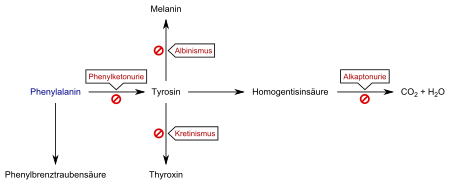Alkaptonuria
| Classification according to ICD-10 | |
|---|---|
| E70.2 | Disorders of the tyrosine metabolism Alkaptonuria |
| ICD-10 online (WHO version 2019) | |
Alkaptonuria is a rare, mostly autosomal - recessively inherited, pathological change in the phenylalanine and tyrosine metabolism due to a defect or deficiency in the enzyme homogentisate dioxygenase (EC number 1.13.11.5). This leads to an increased accumulation of the degradation product Homogentisat . Alkapton refers to the oxidized, black-brown form of the homogenate, among other things in the urine , hence alkaptonuria .
Clinical picture
The build-up of breakdown products of the tyrosine metabolism leads to crystal deposits in the joints with gout-like inflammation of the joints and brown-black discoloration of the cartilage ( ochronosis ). Dark spots appear in the dermis of the eye . There is a visible diffuse discoloration of the cartilage helix of the ear. The disease can also lead to kidney stones and calcification of the aortic valves .
Diagnosis
The urine turns black when bases such as NaOH are added.
treatment
There is no known treatment method that can cure the disease. A diet low in phenylalanine and tyrosine in combination with high doses of ascorbic acid (vitamin C) is recommended for symptomatic treatment . However, this only has an effect if it is started in childhood. In old age she can no longer change the course.
See also
Individual evidence
- ↑ ENZYME entry: EC 1.13.11.5 ( English ) SIB ExPASy Bioformatics Resources Portal. Retrieved January 18, 2018.
- ↑ Ludwig Weissbecker: Alkaptonuria (ochronosis). In: Ludwig Heilmeyer (ed.): Textbook of internal medicine. Springer-Verlag, Berlin / Göttingen / Heidelberg 1955; 2nd edition ibid 1961, p. 1112 f.
